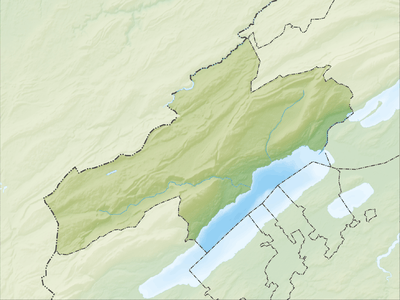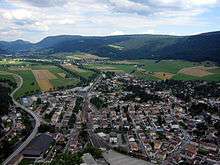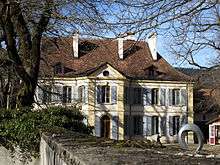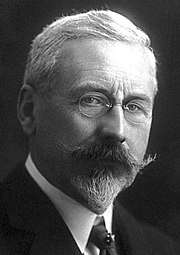Val-de-Travers
Val-de-Travers is a municipality in the Val-de-Travers District in the canton of Neuchâtel in Switzerland. It was created on 1 January 2009, when the former municipalities of Boveresse, Buttes, Couvet, Fleurier, Les Bayards, Môtiers, Noiraigue, Saint-Sulpice and Travers merged to form Val-de-Travers.[3]
Val-de-Travers | |
|---|---|
..jpg) | |
 Coat of arms | |
Location of Val-de-Travers 
| |
 Val-de-Travers  Val-de-Travers | |
| Coordinates: 46°54′N 6°36′E | |
| Country | Switzerland |
| Canton | Neuchâtel |
| District | Val-de-Travers |
| Area | |
| • Total | 124.94 km2 (48.24 sq mi) |
| Elevation | 737 m (2,418 ft) |
| Population (2018-12-31)[2] | |
| • Total | 10,668 |
| • Density | 85/km2 (220/sq mi) |
| Postal code | 2112 |
| SFOS number | 6512 |
| Website | www SFSO statistics |
The region is known for its production of absinthe.
History
Val-de-Travers is first mentioned in 1150 as Vallis traversis.[4]
Geography


Val-de-Travers has an area, as of 2009, of 124.9 square kilometers (48.2 sq mi). Of this area, 52.92 km2 (20.43 sq mi) or 42.4% is used for agricultural purposes, while 63.24 km2 (24.42 sq mi) or 50.6% is forested. Of the rest of the land, 7.54 km2 (2.91 sq mi) or 6.0% is settled (buildings or roads), 0.59 km2 (0.23 sq mi) or 0.5% is either rivers or lakes and 0.39 km2 (0.15 sq mi) or 0.3% is unproductive land.[5]
Of the built up area, housing and buildings made up 2.5% and transportation infrastructure made up 2.5%. Out of the forested land, 46.8% of the total land area is heavily forested and 3.8% is covered with orchards or small clusters of trees. Of the agricultural land, 5.0% is used for growing crops and 23.9% is pastures and 13.4% is used for alpine pastures. All the water in the municipality is flowing water.[5]
The municipality is located in a valley in the Neuchâtel Jura. The valley provides a connection between the Swiss Plateau and Franche-Comté.
The river L'Areuse (previous called La Reuse, the name morphed into Areuse), flows lengthways of the valley, most of this river is a shallow river, and about 10 meters wide, it narrows into a gorge near Noiraigue. historically, this river provided much of the water and fish for the valley.
Demographics

Val-de-Travers had a population (as of December 2018) of 10,668.[6] As of 2008, 18.0% of the population are resident foreign nationals.[7] In the 10 years (2000–2010) the population decreased by 2.5%. Migration accounted for -1.8% whilst births and deaths accounted for -1.6%.[8]
Most of the population (as of 2000) speaks French (88.9%) as their first language, Italian is the second most common (3.0%) and German is the third (2.7%).[8]
As of 2008 the population was 48.6% male and 51.4% female. The population was made up of 4,161 Swiss men (38.4% of the population) and 1,103 (10.2%) non-Swiss men. There were 4,677 Swiss women (43.2%) and 891 (8.2%) non-Swiss women.[9]
As of 2000, children and teenagers (0–19 years old) make up 25% of the population, while adults (20–64 years old) make up 55.9% and seniors (over 64 years old) make up 19.1%.[8]
As of 2009, the construction rate of new housing units was 0.6 new units per 1000 residents.[8] The vacancy rate for the municipality, in 2010, was 1.39%.[8]
Heritage sites of national significance
The Farm House no. 1201 or Monlési, the Maison des Chats or Petitpierre, the Séchoir à absinthe, Ivernois Castle and the Maison Boy de la Tour, the Hôtel des Six-Communes, the medieval church of St-Pierre, the Temple in Môtiers and Areuse Bridge are listed as Swiss heritage site of national significance. The villages of Buttes, Les Verrières, Môtiers, Couvet, Fleurier and Travers are all part of the Inventory of Swiss Heritage Sites.[10]
- Farm House no. 1201 or Monlési
 Maison des chats
Maison des chats Séchoir à absinthe in Boveresse, this particular 'rocks' back and forth because of the wind, it creates a draft used to help dry the wormwood.
Séchoir à absinthe in Boveresse, this particular 'rocks' back and forth because of the wind, it creates a draft used to help dry the wormwood. Ivernois Castle, Maison Boy de la Tour
Ivernois Castle, Maison Boy de la Tour Motiers-Hotel-Six-Communes, previously used to be a midway station, used to house stables and rooms amongst other services. Romans also used a location near the Six-Communes for the same purpose
Motiers-Hotel-Six-Communes, previously used to be a midway station, used to house stables and rooms amongst other services. Romans also used a location near the Six-Communes for the same purpose Medieval church of St-Pierre
Medieval church of St-Pierre Temple of Môtiers
Temple of Môtiers Areuse Bridge
Areuse Bridge
Economy

As of 2010, Val-de-Travers had an unemployment rate of 6.6%. As of 2008, there were 322 people employed in the primary economic sector and about 139 businesses involved in this sector. 1,980 people were employed in the secondary sector and there were 162 businesses in this sector. 2,188 people were employed in the tertiary sector, with 374 businesses in this sector.[8] There were residents of the municipality who were employed in some capacity. Of the working population, 13.1% used public transportation to get to work, and 57.3% used a private car.[8]
Education
In the canton of Neuchâtel most municipalities provide two years of non-mandatory kindergarten, followed by five years of mandatory primary education. The next four years of mandatory secondary education is provided at thirteen larger secondary schools, which many students travel out of their home municipality to attend.[11] During the 2010-11 school year, there were 10.5 kindergarten classes with a total of 198 students in Val-de-Travers. In the same year, there were 29 primary classes with a total of 528 students.[12]
Transportation
The municipality has seven railway stations. Two, Travers and Noiraigue, are located on the Neuchâtel–Pontarlier line with service to Neuchâtel and France. The other five are located on the Travers–Buttes line, which also servers Travers.
Notable people


- Emer de Vattel (1714 in Couvet – 1767) an international lawyer
- Ferdinand Berthoud (1727 in Plancemont-sur-Couvet - 1807) a scientist and watchmaker
- Jonas de Gélieu (1740 in Les Bayards - 1827) a Swiss pastor and beekeeper
- Salomé de Gélieu (1742 in Les Bayards - 1820) a Swiss educator and governess to several members of princely courts in Europe
- Léo Lesquereux (1806 in Fleurier – 1889) a Swiss bryologist and a pioneer of American paleobotany
- Édouard Piaget (1817 in Les Bayards – 1910) a Swiss entomologist who specialised in lice
- Charles Édouard Guillaume (1861 in Fleurier – 1938) a Swiss physicist who received the Nobel Prize in Physics in 1920
- Édouard Bovet (1797 in Fleurier – 1849) a Swiss watchmaker and founder of the Bovet Fleurier watch company
- Denis de Rougemont (1906 in Couvet – 1985) a Swiss writer and cultural theorist
- Daniel Bovet (1907 in Fleurier – 1992) a Swiss-born Italian pharmacologist who won the 1957 Nobel Prize in Physiology or Medicine for his discovery of drugs that block the actions of specific neurotransmitters
- Fritz Tschannen (1920 – 2011 in Val-de-Travers) a Swiss accordion player, former ski jumper who competed at the 1948 Winter Olympics and a conductor until 1999, when he retired to Fleurier
References
- "Arealstatistik Standard - Gemeinden nach 4 Hauptbereichen". Federal Statistical Office. Retrieved 13 January 2019.
- "Ständige Wohnbevölkerung nach Staatsangehörigkeitskategorie Geschlecht und Gemeinde; Provisorische Jahresergebnisse; 2018". Federal Statistical Office. 9 April 2019. Retrieved 11 April 2019.
- Amtliches Gemeindeverzeichnis der Schweiz published by the Swiss Federal Statistical Office (in German) accessed 14 January 2010
- Val-de-Travers in German, French and Italian in the online Historical Dictionary of Switzerland.
- Swiss Federal Statistical Office-Land Use Statistics 2009 data (in German) accessed 25 March 2010
- Swiss Federal Statistical Office - STAT-TAB, online database – Ständige und nichtständige Wohnbevölkerung nach institutionellen Gliederungen, Geburtsort und Staatsangehörigkeit (in German) accessed 23 September 2019
- Swiss Federal Statistical Office - Superweb database - Gemeinde Statistics 1981-2008 (in German) accessed 19 June 2010
- Swiss Federal Statistical Office accessed 3 November 2011
- Canton of Neuchatel Statistics Archived 5 December 2012 at Archive.today, République et canton de Neuchâtel - Recensement annuel de la population (in German) accessed 13 October 2011
- "Kantonsliste A-Objekte". KGS Inventar (in German). Federal Office of Civil Protection. 2009. Archived from the original on 28 June 2010. Retrieved 25 April 2011.
- EDK/CDIP/IDES (2010). Kantonale Schulstrukturen in der Schweiz und im Fürstentum Liechtenstein / Structures Scolaires Cantonales en Suisse et Dans la Principauté du Liechtenstein (PDF) (Report). Retrieved 24 June 2010.
- Statistical Department of the Canton of Neuchâtel Archived 14 April 2012 at the Wayback Machine Mémento de l'année scolaire 2010/2011 (in French) accessed 17 October 2011
External links
| Wikimedia Commons has media related to Val-de-Travers. |
- Boveresse in German, French and Italian in the online Historical Dictionary of Switzerland.